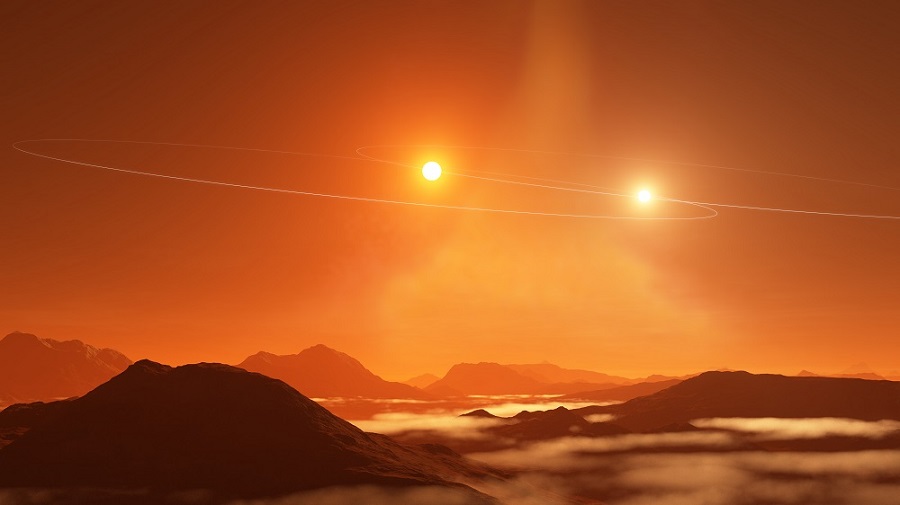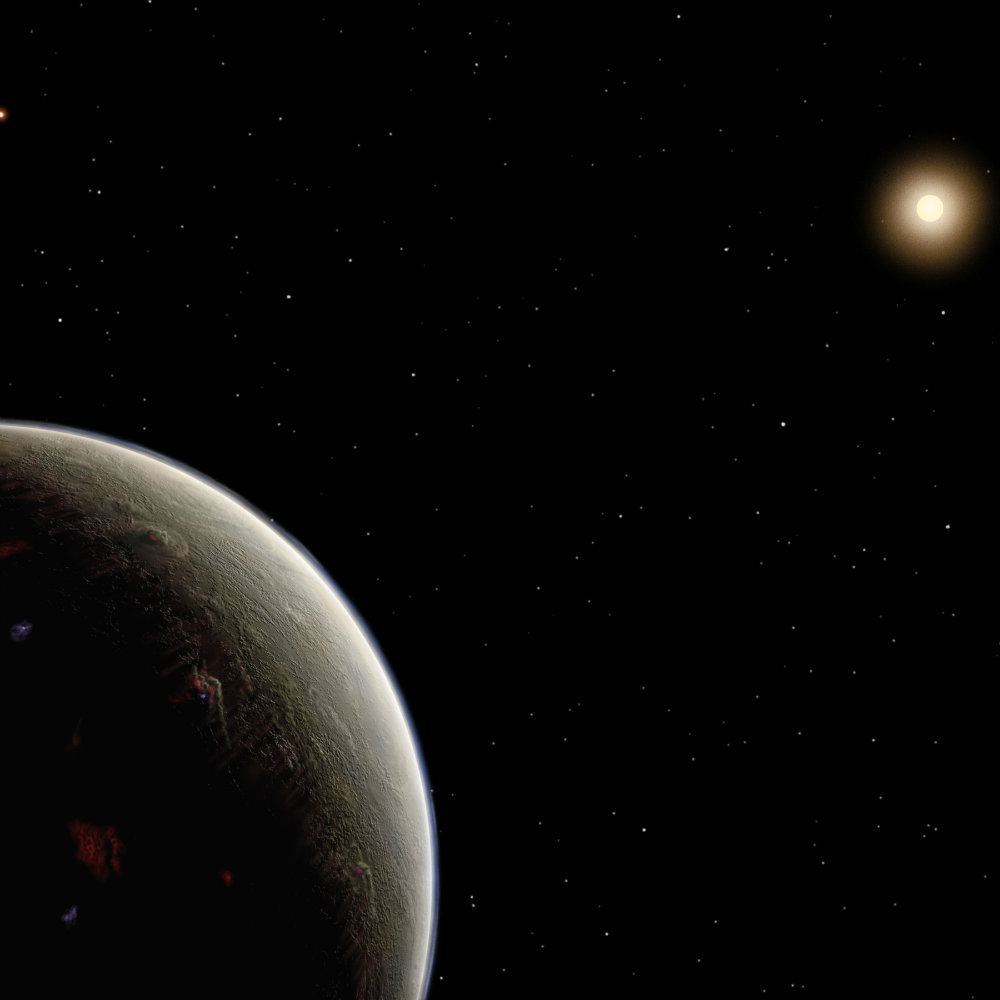There’s an iconic scene in the original Star Wars movie where Luke Skywalker looks out over the desert landscape of Tatooine at the amazing spectacle of a double sunset. Now, a new study out of the National Radio Astronomy Observatory (NRAO) suggests that such exotic exoplanet worlds orbiting multiple stars may exist in misaligned orbits, far out of the primary orbital plane.
Continue reading “Study Finds Bizarre Exoplanet Orbits for Binary Stars”What is a Generation Ship?
The dream of traveling to another star and planting the seed of humanity on a distant planet… It is no exaggeration to say that it has captivated the imaginations of human beings for centuries. With the birth of modern astronomy and the Space Age, scientific proposals have even been made as to how it could be done. But of course, living in a relativistic Universe presents many challenges for which there are no simple solutions.
Of these challenges, one of the greatest has to do with the sheer amount of energy necessary to get humans to another star within their own lifetimes. Hence why some proponents of interstellar travel recommend sending spacecraft that are essentially miniaturized worlds that can accommodate travelers for centuries or longer. These “Generation Ships” (aka. worldships or Interstellar Arks) are spacecraft that are built for the truly long haul.
Continue reading “What is a Generation Ship?”Astronomers Image the Atmosphere of a Red Dwarf Planet for the First Time. Spoiler Alert, it’s a Terrible Place to Live

The field of exoplanet research continues to grow by leaps and bounds. Thanks to missions like the Kepler Space Telescope, over four-thousand
For instance, a group of astronomers was able to image the surface of a planet orbiting a red dwarf star for the first time. Using data from the NASA Spitzer Space Telescope, the team was able to provide a rare glimpse at the conditions on the planet’s surface. And while those conditions were rather inhospitable – akin to something like Hades, but with less air to breathe – this represents a major breakthrough in the study of exoplanets.
Continue reading “Astronomers Image the Atmosphere of a Red Dwarf Planet for the First Time. Spoiler Alert, it’s a Terrible Place to Live”Ground-Based Telescope Directly Observes the Atmosphere of an Extrasolar Planet, and Sees Swirling Clouds of Iron and Silicates
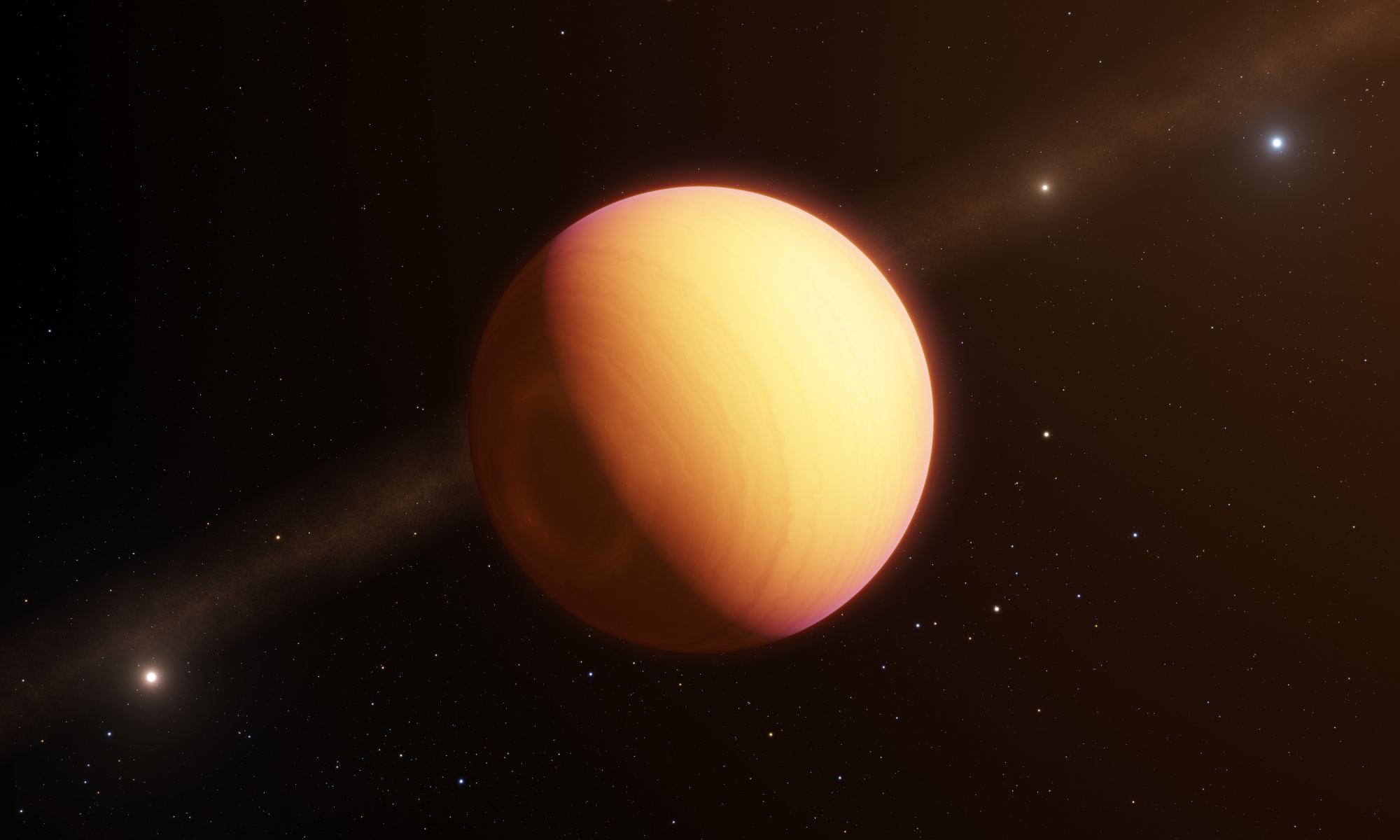
We’ve finally got our first optical look at an exoplanet and its atmosphere, and boy is it a strange place. The planet is called HR8799e, and its atmosphere is a complex one. HR8799e is in the grips of a global storm, dominated by swirling clouds of iron and silicates.
Continue reading “Ground-Based Telescope Directly Observes the Atmosphere of an Extrasolar Planet, and Sees Swirling Clouds of Iron and Silicates”Astronomers find Planet Vulcan – 40 Eridani A – Right Where Star Trek Predicted it.
One of the more interesting and rewarding aspects of astronomy and space exploration is seeing science fiction become science fact. While we are still many years away from colonizing the Solar System or reaching the nearest stars (if we ever do), there are still many rewarding discoveries being made that are fulfilling the fevered dreams of science fiction fans.
For instance, using the Dharma Planet Survey, an international team of scientists recently discovered a super-Earth orbiting a star just 16 light-years away. This super-Earth is not only the closest planet of its kind to the Solar System, it also happens to be located in the same star system as the fictional planet Vulcan from the Star Trek universe.
What’s the Minimum Number of People you Should Send in a Generational Ship to Proxima Centauri?
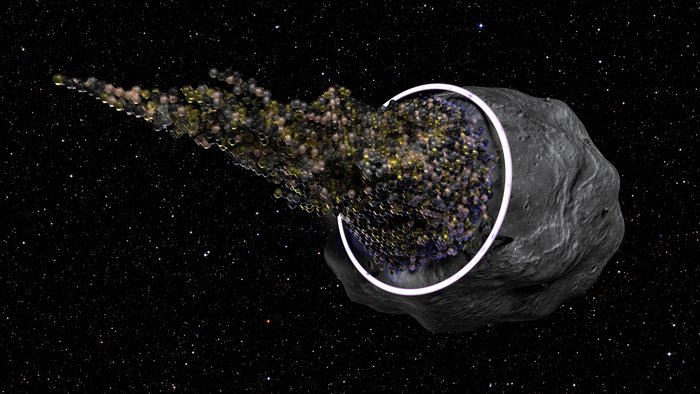
Humanity has long dreamed about sending humans to other planets, even before crewed spaceflight became a reality. And with the discovery of thousands of exoplanets in recent decades, particularly those that orbit within neighboring star systems (like Proxima b), that dream seems closer than ever to becoming a reality. But of course, a lot of technical challenges need to be overcome before we can hope to mount such a mission.
In addition, a lot of questions need to be answered. For example, what kind of ship should we send to Proxima b or other nearby exoplanets? And how many people would we need to place aboard that ship? The latter question was the subject of a recent paper written by a team of French researchers who calculated the minimal number of people that would be needed in order to ensure that a healthy multi-generational crew could make the journey to Proxima b.
Continue reading “What’s the Minimum Number of People you Should Send in a Generational Ship to Proxima Centauri?”TRAPPIST-1 Planets Might Actually Have Too Much Water to be Habitable

In February of 2017, the world was astounded to learn that astronomers – using data from the TRAPPIST telescope in Chile and the Spitzer Space Telescope – had identified a system of seven rocky exoplanets in the TRAPPIST-1 system. As if this wasn’t encouraging enough for exoplanet-enthusiasts, it was also indicated that three of the seven planets orbited within the stars’ circumstellar habitable zone (aka. “Goldilocks Zone”).
Since that time, this system has been the focus of considerable research and follow-up surveys to determine whether or not any of its planets could be habitable. Intrinsic to these studies has been the question whether or not the planets have liquid water on their surfaces. But according to a new study by a team of American astronomers, the TRAPPIST planets may actually have too much water to support life.
Continue reading “TRAPPIST-1 Planets Might Actually Have Too Much Water to be Habitable”
Upcoming Telescopes Should be Able to Detect Mountains and Other Landscapes on Extrasolar Planets

The study of exoplanets has advanced by leaps and bounds in the past few decades. Between ground-based observatories and spacecraft like the Kepler mission, a total of 3,726 exoplanets have been confirmed in 2,792 systems, with 622 systems having more than one planet (as of Jan. 1st, 2018). And in the coming years, scientists expect that many more discoveries will be possible thanks to the deployment of next-generation missions.
These include NASA’s James Webb Space Telescope (JWST) and several next-generation ground based observatories. With their advanced instruments, these and other observatories are not only expected to find many more exoplanets, but to reveal new and fascinating things about them. For instance, a recent study from Columbia University indicated that it will be possible, using the Transit Method, to study surface elevations on exoplanets.
The study, which recently appeared online under the title “Finding Mountains with Molehills: The Detectability of Exotopography“, was conducted by Moiya McTier and David Kipping – and graduate student and an Assistant Professor of Astronomy at Columbia University, respectively. Based on models they created using bodies in our Solar System, the team considered whether transit surveys might be able to reveal topographical data on exoplanets.
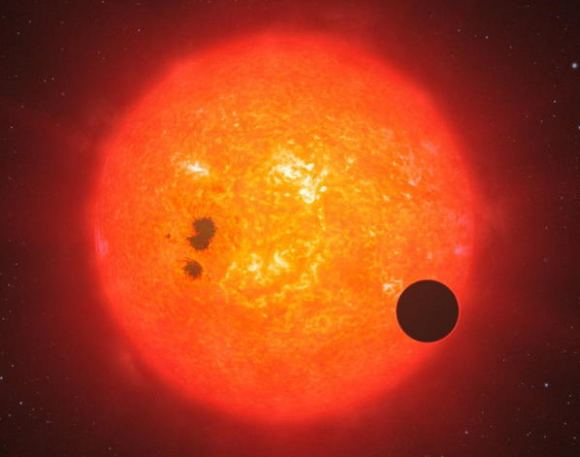
To recap, the Transit Method (aka. Transit Photometry) is currently the most popular and reliable means for detecting exoplanets. It consists of astronomers measuring the light curve of distant stars over time and looking for periodic dips in brightness. These dips are the result of exoplanets passing in front of the star (i.e. transiting) relative to the observer.
By measuring the rate at which the star’s light dips, and the period with which the dimming occurs, astronomer are not only able to determine the presence of exoplanets, but also place accurate constraints on their size and orbital periods. According to McTier and Kipping, this same method could also reveal the presence of geographical features – for instance, mountain ranges, volcanoes, trenches, and craters.
As they indicate in their study, in lieu of direct imaging, indirect methods are the only means astronomers have for revealing data on an exoplanet’s surface. Unfortunately, there is no conceivable way that the radial velocity, microlensing, astrometry, and timing methods could reveal exotopography. This leaves the transit method, which has some potential in this respect. As they state:
“The transit method directly measures the sky-projected area of a planet’s silhouette relative to that of a star, under the assumption that the planet is not luminous itself… This fact implies that there is indeed some potential for transits to reveal surface features, since the planet’s silhouette is certainly distorted from a circular profile due to the presence of topography.”
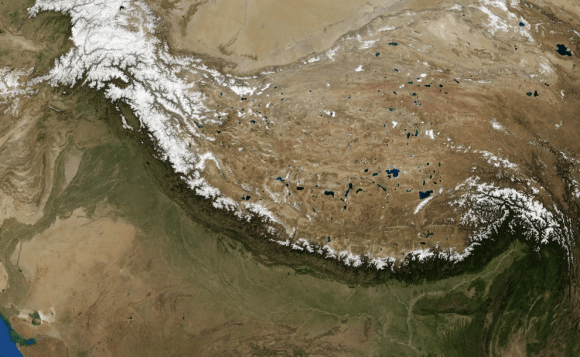
In other words, as a planet transits in front of its host star, the light passing around the planet itself could be measured for small variations. These could indicate the presence of mountain ranges and other large-scale features like massive chasms. To test this theory, they considered planets in the Solar System as templates for how the scattering of light during a transit could reveal large-scale features.
As an example, they consider what an Earth analog planet would reveal if the Himalayan mountain range ran from north to south and was wide enough to span 1° in longitude:
“Now assume that the planet completes half of one rotation as it transits its parent star from our point of view, which is all that is necessary to see all of the planet’s features appear on its silhouette without repeating. As our hypothetical planet rotates and the Himalayan block moves into and out of view, the change in silhouette will result in different transit depths…”
Ultimately, they consider that Mars would be the ideal test case due to its combination of small size, low surface gravity, and active internal volcanism, which has caused it become what they describe as the “bumpiest body in the Solar System”. When paired with a white dwarf star, this presents the optimal case for using light curves to determine exotopography.
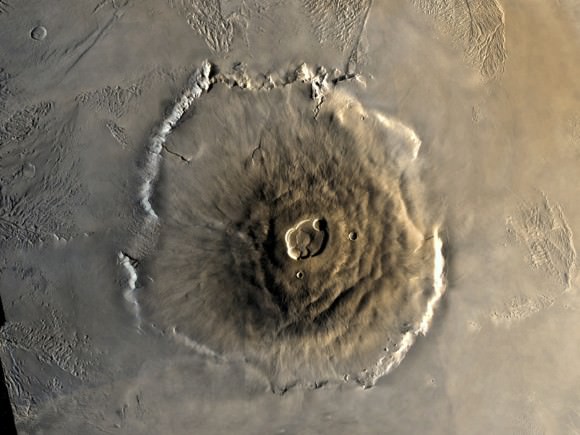
At a distance of about 0.01 AU (which would be within a white dwarf’s habitable zone), they calculate that a Mars-sized planet would have an orbital period of 11.3 hours. This would allow for many transits to be observed in a relatively short viewing period, thus ensuring a greater degree of accuracy. At the same time, the team admits that their proposed methods suffers from drawbacks.
For instance, due to the presence of astrophysical and instrumental noise, they determined that their method would be unproductive when it comes to studying exoplanets around Sun-like stars and M-type (red dwarf) stars. But for Mars-like planets orbiting low mass, white dwarf stars, the method could produce some highly valuable scientific returns.
While this might sound rather limited, it would present some rather fascinating opportunities to learn more about planets beyond our Solar System. As they explain:
“Finding the first evidence of mountains on planets outside our solar system would be exciting in its own right, but we can also infer planet characteristics from the presence and distribution of surface features. For example, a detection of bumpiness could lead to constraints on a planet’s internal processes.”
In short, planets with a high degree of bumpiness would indicate tectonic activity or the buildup of lava caused by internal heating sources. Those with the highest bumpiness (i.e. like Mars) would indicate that they too experience a combination internal processes, low surface gravity, volcanism, and a lack of tectonic plate movement. Meanwhile, low-bumpiness planets are less likely to have any of these internal processes and their surfaces are more likely to be shaped by external factors – like asteroid bombardment.

Based on their estimates, they conclude that the various super telescopes that are scheduled to be commissioned in the coming years would be up to task. These include the ESO’s OverWhelmingly Large (OWL) Telescope, a 100-meter proposed optical and near-infrared telescope that would build on the success of the Very Large Telescope (VLT) and the upcoming Extremely Large Telescope (ELT).
Another example is the Colossus Telescope, a 74-meter optical and infrared telescope that is currently being commissioned by an international consortium. Once operational, it will be the largest telescope optimized for detecting extrasolar life and extraterrestrial civilizations.
In the past, the success of exoplanet hunters has come down to a combination of factors. In addition to greater levels of cooperation between institutions, amateur astronomers and citizen scientists, there has also been the way in which improved technology has coincided with new theoretical models. As more data become available, scientists are able to produce more educated estimates on what we might be able to learn once new instruments come online.
When the next-generation telescopes take to space or are finished construction here on Earth, we can anticipate that thousands more exoplanets will be found. At the same time, we can anticipate that important details will be also discovered about these planets that were not possible before. Do they have atmospheres? Do they have oceans? Do they have mountain ranges and chasms? We hope to find out!
Further Reading: arXiv
Using Atmospheric Beacons to Search for Signs of Extra-Terrestrial Life
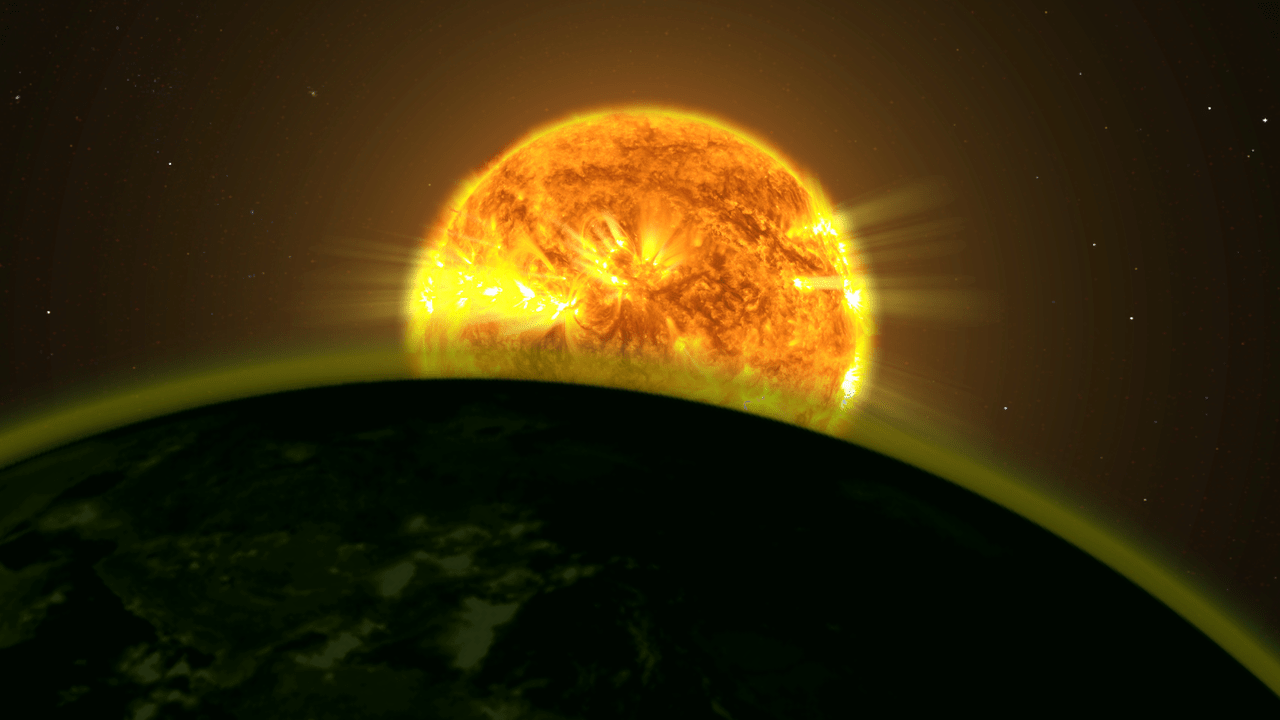
Despite the thousands of exoplanets that have been discovered by astronomers in recent years, determining whether or not any of them are habitable is a major challenge. Since we cannot study these planets directly, scientists are forced to look for indirect indications. These are known as biosignatures, which consist of the chemical byproducts we associate with organic life showing up in a planet’s atmosphere.
A new study by a team of NASA scientists proposes a new method to search for potential signs of life beyond our Solar System. The key, they recommend, is to takes advantage of frequent stellar storms from cool, young dwarf stars. These storms hurl huge clouds of stellar material and radiation into space, interacting with exoplanet atmospheres and producing biosignatures that could be detected.
The study, titled “Atmospheric Beacons of Life from Exoplanets Around G and K Stars“, recently appeared in Nature Scientific Reports. Led by Vladimir S. Airapetian, a senior astrophysicist with the Heliophysics Science Division (HSD) at the NASA Goddard Space Flight Center, the team included members from NASA’s Langley Research Center, the Science Systems and Applications Incorporated (SSAI), and the American University.
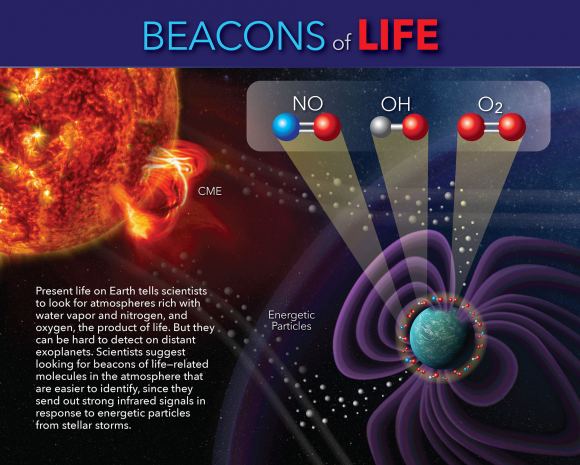
Traditionally, researchers have searched for signs of oxygen and methane in exoplanet atmospheres, since these are well-known byproducts of organic processes. Over time, these gases accumulate, reaching amounts that could be detected using spectroscopy. However, this approach is time-consuming and requires that astronomers spend days trying to observe spectra from a distant planet.
But according to Airapetian and his colleagues, it is possible to search for cruder signatures on potentially habitable worlds. This approach would rely on existing technology and resources and would take considerably less time. As Airapetian explained in a NASA press release:
“We’re in search of molecules formed from fundamental prerequisites to life — specifically molecular nitrogen, which is 78 percent of our atmosphere. These are basic molecules that are biologically friendly and have strong infrared emitting power, increasing our chance of detecting them.”
Using life on Earth as a template, Airapetian and his team designed a new method to look or signs of water vapor, nitrogen and oxygen gas byproducts in exoplanets atmospheres. The real trick, however, is to take advantage of the kinds of extreme space weather events that occur with active dwarf stars. These events, which expose planetary atmospheres to bursts of radiation, cause chemical reactions that astronomers can pick on.
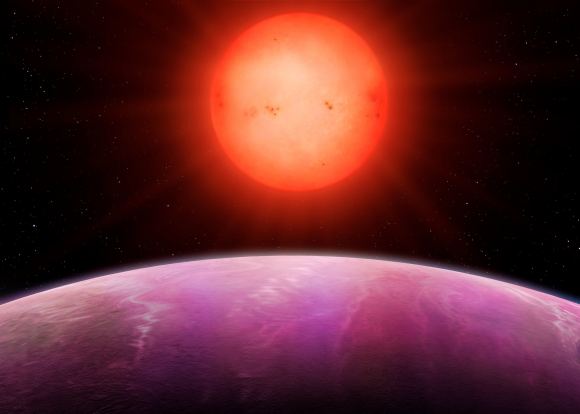
When it comes to stars like our Sun, a G-type yellow dwarf, such weather events are common when they are still young. However, other yellow and orange stars are known to remain active for billions of years, producing storms of energetic, charged particles. And M-type (red dwarf) stars, the most common type in the Universe, remain active throughout their long-lives, periodically subjecting their planets to mini-flares.
When these reach an exoplanet, they react with the atmosphere and cause the chemical dissociation of nitrogen (N²) and oxygen (O²) gas into single atoms, and water vapor into hydrogen and oxygen. The broken down nitrogen and oxygen atoms then cause a cascade of chemical reactions which produce hydroxyl (OH), more molecular oxygen (O), and nitric oxide (NO) – what scientists refer to as “atmospheric beacons”.
When starlight hits a planet’s atmosphere, these beacon molecules absorb the energy and emit infrared radiation. By examining the particular wavelengths of this radiation, scientists are able to determine what chemical elements are present. The signal strength of these elements is also an indication of atmospheric pressure. Taken together, these readings allow scientist’s to determine an atmosphere’s density and composition.
For decades, astronomers have also used a model to calculate how ozone (O³) is formed in Earth’s atmosphere from oxygen that is exposed to solar radiation. Using this same model – and pairing it with space weather events that are expected from cool, active stars – Airapetian and his colleagues sought to calculate just how much nitric oxide and hydroxyl would form in an Earth-like atmosphere and how much ozone would be destroyed.
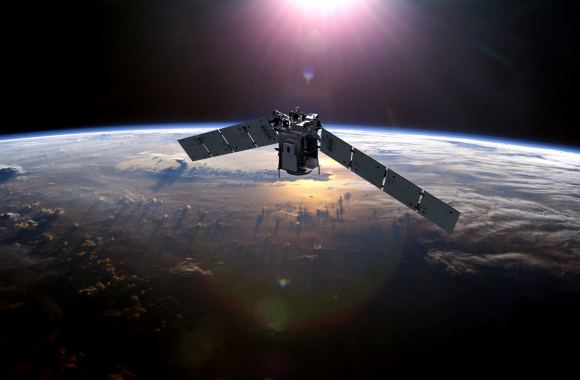
To accomplish this, they consulted data from NASA’s Thermosphere Ionosphere Mesosphere Energetics Dynamics (TIMED) mission, which has been studying the formation of beacons in Earth’s atmosphere for years. Specifically, they used data from its Sounding of the Atmosphere using Broadband Emission Radiometry (SABER) instrument, which allowed them to simulate how infrared observations of these beacons might appear in exoplanet atmospheres.
As Martin Mlynczak, the SABER associate principal investigator at NASA’s Langley Research Center and a co-author of the paper, indicated:
“Taking what we know about infrared radiation emitted by Earth’s atmosphere, the idea is to look at exoplanets and see what sort of signals we can detect. If we find exoplanet signals in nearly the same proportion as Earth’s, we could say that planet is a good candidate for hosting life.”
What they found was that the frequency of intense stellar storms was directly related to the strength of the heat signals coming from the atmospheric beacons. The more storms occur, the more beacon molecules are created, generating a signal strong enough to be observed from Earth with a space telescope, and based on just two hours of observation time.
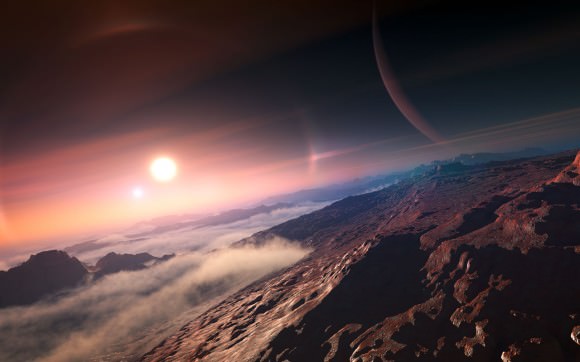
They also found that this kind of method can weed out exoplanets that do not possess an Earth-like magnetic field, which naturally interact with charged particles from the Sun. The presence of such a field is what ensures that a planet’s atmosphere is not stripped away, and is therefore essential to habitability. As Airapetian explained:
“A planet needs a magnetic field, which shields the atmosphere and protects the planet from stellar storms and radiation. If stellar winds aren’t so extreme as to compress an exoplanet’s magnetic field close to its surface, the magnetic field prevents atmospheric escape, so there are more particles in the atmosphere and a stronger resulting infrared signal.”
This new model is significant for several reasons. On the one hand, it shows how research that has enabled detailed studies of Earth’s atmosphere and how it interacts with space weather is now being put towards the study of exoplanets. It is also exciting because it could allow for new studies of exoplanet habitability around certain classes of stars – ranging from many types of yellow and orange stars to cool, red dwarf stars.
Red dwarfs are the most common type of star in the Universe, accounting for 70% of stars in spiral galaxies and 90% in elliptical galaxies. What’s more, based on recent discoveries, astronomers estimate that red dwarf stars are very likely to have systems of rocky planets. The research team also anticipates that next-generation space instruments like the James Webb Space Telescope will increase the likelihood of finding habitable planets using this model.
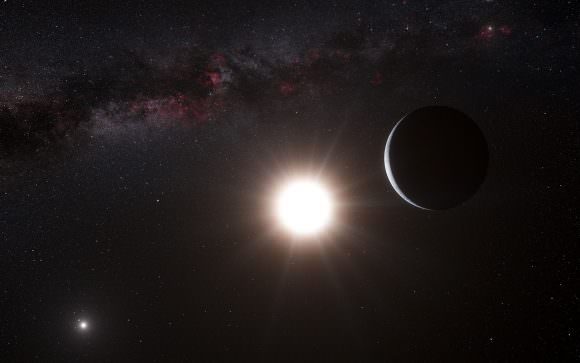
As William Danchi, a Goddard senior astrophysicist and co-author on the study, said:
“New insights on the potential for life on exoplanets depend critically on interdisciplinary research in which data, models and techniques are utilized from NASA Goddard’s four science divisions: heliophysics, astrophysics, planetary and Earth sciences. This mixture produces unique and powerful new pathways for exoplanet research.”
Until such time that we are able to study exoplanets directly, any development that makes biosignatures more discernible and easier to detect is incredibly valuable. In the coming years, Project Blue and Breakthrough Starshot are hoping to conduct the first direct studies of the Alpha Centauri system. But in the meantime, improved models that allow us to survey countless other stars for potentially habitable exoplanets are golden!
Not only will they vastly improve our understanding of just how common such planets are, they might just point us in the direction of one or more Earth 2.0s!
Further Reading: NASA, Nature Scientific Reports
“Monster Planet” Discovered, Makes Scientists Rethink Theories of Planetary Formation
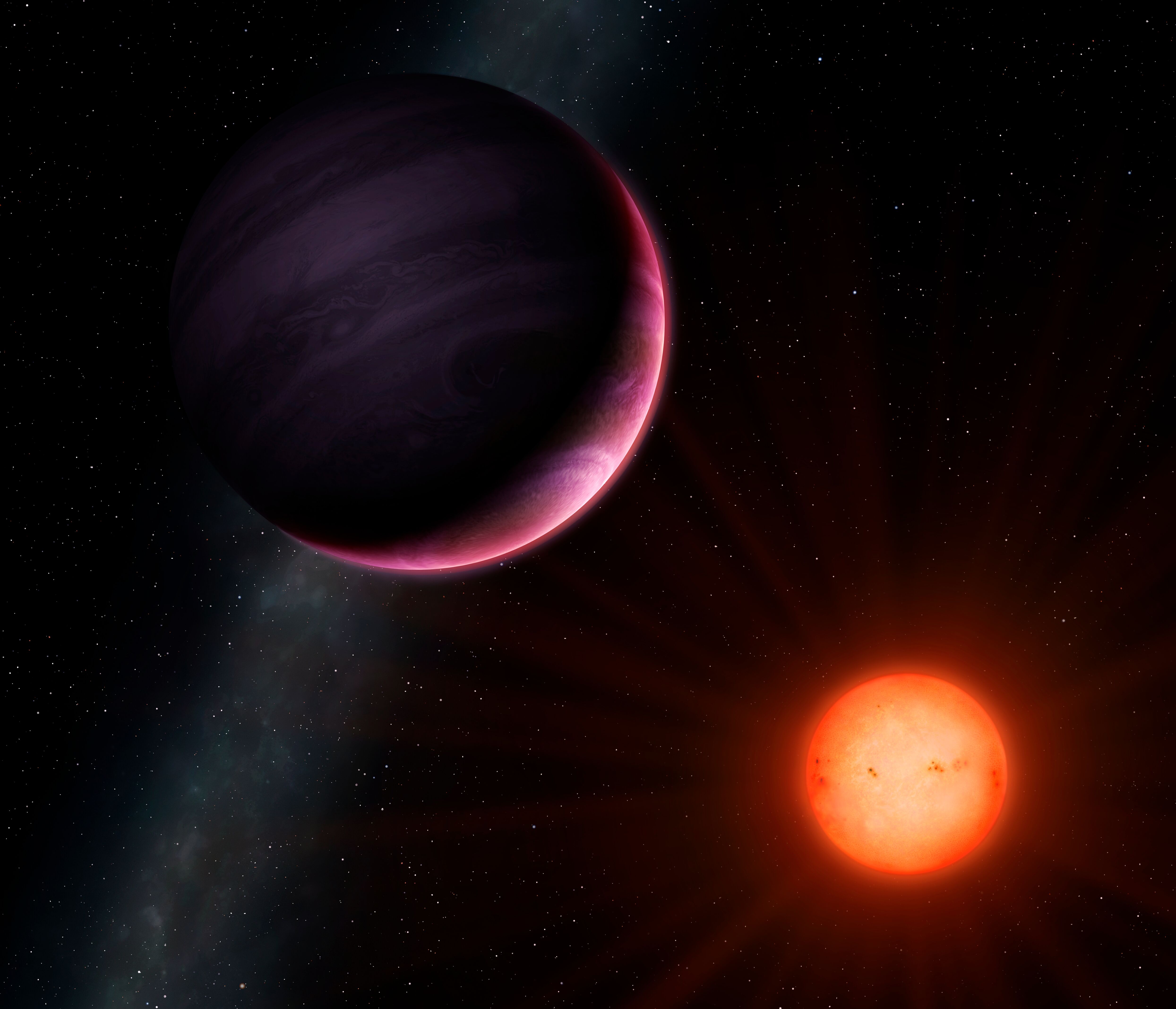
When it comes to how and where planetary systems form, astronomers thought they had a pretty good handle on things. The predominant theory, known as the Nebular Hypothesis, states that stars and planets form from massive clouds of dust and gas (i.e. nebulae). Once this cloud experiences gravitational collapse at the center, its remaining dust and gas forms a protoplanetary disk that eventually accretes to form planets.
However, when studying the distant star NGTS-1 – an M-type (red dwarf) located about 600 light-years away – an international team led by astronomers from the University of Warwick discovered a massive “hot Jupiter” that appeared far too large to be orbiting such a small star. The discovery of this “monster planet” has naturally challenged some previously-held notions about planetary formation.
The study, titled “NGTS-1b: A hot Jupiter transiting an M-dwarf“, recently appeared in the Monthly Notices of the Royal Astronomical Society. The team was led by Dr Daniel Bayliss and Professor Peter Wheatley from the University of Warwick and included members from the of the Geneva Observatory, the Cavendish Laboratory, the German Aerospace Center, the Leicester Institute of Space and Earth Observation, the TU Berlin Center for Astronomy and Astrophysics, and multiple universities and research institutes.

The discovery was made using data obtained by the ESO’s Next-Generation Transit Survey (NGTS) facility, which is located at the Paranal Observatory in Chile. This facility is run by an international consortium of astronomers who come from the Universities of Warwick, Leicester, Cambridge, Queen’s University Belfast, the Geneva Observatory, the German Aerospace Center, and the University of Chile.
Using a full array of fully-robotic compact telescopes, this photometric survey is one of several projects meant to compliment the Kepler Space Telescope. Like Kepler, it monitors distant stars for signs of sudden dips in brightness, which are an indication of a planet passing in front of (aka. “transiting”) the star, relative to the observer. When examining data obtained from NGTS-1, the first star to be found by the survey, they made a surprising discovery.
Based on the signal produced by its exoplanet (NGTS-1b), they determined that it was a gas giant roughly the same size as Jupiter and almost as massive (0.812 Jupiter masses). Its orbital period of 2.6 days also indicated that it orbits very close to its star – about 0.0326 AU – which makes it a “hot Jupiter”. Based on these parameters, the team also estimated that NGTS-1b experiences temperatures of approximately 800 K (530°C; 986 °F).
The discovery threw the team for a loop, as it was believed to be impossible for planets of this size to form around small, M-type stars. In accordance with current theories about planet formation, red dwarf stars are believed to be able to form rocky planets – as evidenced by the many that have been discovered around red dwarfs of late – but are unable to gather enough material to create Jupiter-sized planets.
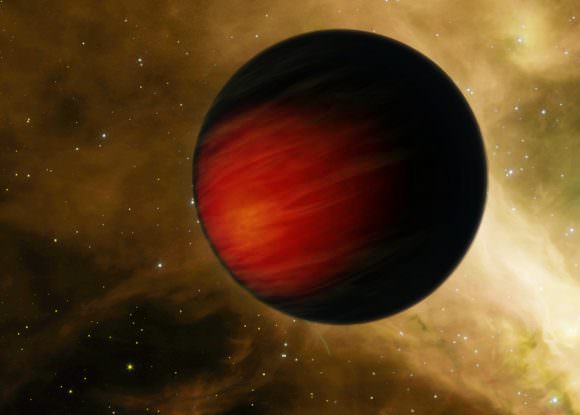
As Dr. Daniel Bayliss, an astronomer with the University of Geneva and the lead-author on the paper, commented in University of Warwick press release:
“The discovery of NGTS-1b was a complete surprise to us – such massive planets were not thought to exist around such small stars. This is the first exoplanet we have found with our new NGTS facility and we are already challenging the received wisdom of how planets form. Our challenge is to now find out how common these types of planets are in the Galaxy, and with the new NGTS facility we are well-placed to do just that.”
What is also impressive is the fact that the astronomers noticed the transit at all. Compared to other classes of stars, M-type stars are the smallest, coolest and dimmest. In the past, rocky bodies have been detected around them by measuring shifts in their position relative to Earth (aka. the Radial Velocity Method). These shifts are caused by the gravitational tug of one or more planets that cause the planet to “wobble” back and forth.
In short, the low light of an M-type star has made monitoring them for dips in brightness (aka. the Transit Method) highly impractical. However, using the NGTS’s red-sensitive cameras, the team was able to monitored patches of the night sky for many months. Over time, they noticed dips coming from NGTS-1 every 2.6 days, which indicated that a planet with a short orbital period was periodically passing in front of it.

They then tracked the planet’s orbit around the star and combined the transit data with Radial Velocity measurements to determine its size, position and mass. As Professor Peter Wheatley (who leads NGTS) indicated, finding the planet was painstaking work. But in the end, its discovery could lead to the detection of many more gas giants around low-mass stars:
“NGTS-1b was difficult to find, despite being a monster of a planet, because its parent star is small and faint. Small stars are actually the most common in the universe, so it is possible that there are many of these giant planets waiting to found. Having worked for almost a decade to develop the NGTS telescope array, it is thrilling to see it picking out new and unexpected types of planets. I’m looking forward to seeing what other kinds of exciting new planets we can turn up.”
Within the known Universe, M-type stars are by far the most common, accounting for 75% of all stars in the Milky Way Galaxy alone. In the past, the discovery of rocky bodies around stars like Proxima Centauri, LHS 1140, GJ 625, and the seven rocky planets around TRAPPIST-1, led many in the astronomical community to conclude that red dwarf stars were the best place to look for Earth-like planets.
The discovery of a Hot Jupiter orbiting NGTS-1 is therefore seen as an indication that other red dwarf stars could have orbiting gas giants as well. Above all, this latest find once again demonstrates the importance of exoplanet research. With every find we make beyond our Solar System, the more we learn about the ways in which planets form and evolve.
Every discovery we make also advances our understanding of how likely we may be to discover life out there somewhere. For in the end, what greater scientific goal is there than determining whether or not we are alone in the Universe?
Further Reading: UofWarwick, RAS, MNRAS

